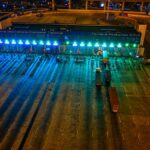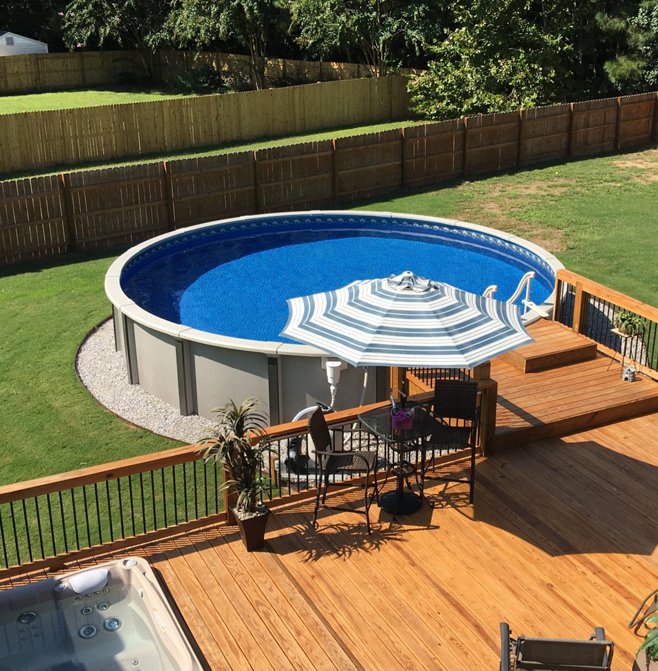Discover the fundamental fundamentals of automatic pool chlorinators. This informative article explores the inner workings, advantages, disadvantages, and various types of these essential devices for maintaining a pristine swimming environment.
Dive into the precise dispensing of chlorine, the connection to filtration systems, and the role in preventing water-borne illnesses.
Uncover the cost-effective inline and offline options and gain insight into the comparison with automatic chemical feeders.
Equip yourself with the knowledge to make informed decisions for optimal pool sanitization.
Key Takeaways
- Chlorinators are important for maintaining appropriate chlorine levels in pools, which helps to kill water-borne germs and prevent illnesses.
- Automatic pool chlorinators make pool maintenance easier and more efficient by automatically dispensing the right amount of chlorine.
- There are two types of pool chlorinators: inline and offline. Inline chlorinators are sturdier and have fewer parts to replace, while offline chlorinators are suitable for existing pools with limited installation space.
- Chlorinators are specifically designed for chlorine-based disinfection, while automatic chemical feeders offer more versatility in chemical options. The choice between the two depends on the desired sanitization method.
Operation of Automatic Pool Chlorinators
The operation of automatic pool chlorinators involves the controlled release and distribution of chlorine to maintain proper sanitization levels in the pool. These devices are designed to simplify the process of pool maintenance by automatically adding the necessary amount of chlorine to keep the water clean and safe for swimming.
Automatic pool chlorinators are typically connected to the pump and pool filter system. They can use chlorine tablets or approved liquid chlorine, which are slowly released into the pool water. The chlorinator regulates the flow of chlorine, ensuring that the proper amount is added to maintain the recommended chlorine levels for a clean swim environment.
To ensure the effective functioning of pool chlorinators, proper installation and regular maintenance are crucial. The chlorinator must be properly installed and connected to the pool's filtration system. Regular maintenance includes cleaning the chlorinator and replacing chlorine tablets or liquid as needed.
By using an automatic pool chlorinator, pool owners can enjoy several benefits. These devices make pool maintenance easier and more efficient, as they eliminate the need for manual dosing of chlorine. They also ensure a consistent and controlled release of chlorine, which helps to prevent under or over-chlorination. Additionally, automatic pool chlorinators help to reduce skin and eye irritation that can be caused by improper chlorine levels.
Benefits of Using Automatic Pool Chlorinators
Automatic pool chlorinators offer several benefits that make them a popular choice among pool owners.
Firstly, they ensure efficient distribution of chlorine, resulting in effective water sanitization and the prevention of water-borne illnesses.
Secondly, they simplify pool maintenance by automatically dispensing the right amount of chlorine, reducing the need for manual monitoring and adjustments.
Lastly, they provide convenience and ease of operation, allowing pool owners to enjoy a clean and well-maintained pool with minimal effort.
Efficient Chlorine Distribution
One of the key benefits of using automatic pool chlorinators is their ability to ensure efficient distribution of chlorine throughout the pool. These pool chlorine dispensers are designed to connect to the pump and pool filter system, allowing them to dispense the right amount of chlorine uniformly. This ensures that every corner of the pool is properly sanitized, reducing the risk of algae growth and bacteria buildup.
By consistently maintaining appropriate chlorine levels, automatic pool chlorinators also help to reduce skin and eye irritation for swimmers. Additionally, they eliminate the need for manual chlorine dosing, saving time and effort for pool owners.
With efficient chlorine distribution, automatic pool chlorinators play a crucial role in maintaining a clean and safe swimming environment.
Transitioning into the subsequent section about convenient maintenance and operation, let's explore how these chlorinators make pool upkeep hassle-free.
Convenient Maintenance and Operation
Using an automatic pool chlorinator offers numerous benefits in terms of convenient maintenance and operation.
One of the main advantages is that it eliminates the need for manual dosing of chlorine, saving time and effort. With an automatic chlorinator, you can simply set the desired chlorine level and let the device take care of the rest. This ensures consistent and accurate chlorine distribution, preventing over- or under-chlorination.
Additionally, automatic chlorinators often have built-in timers and controls, allowing you to easily adjust the chlorine levels based on the pool's usage and weather conditions. This makes pool maintenance more efficient and hassle-free.
Improved Water Sanitization
By ensuring consistent and accurate distribution of chlorine, automatic pool chlorinators contribute to the improved water sanitization and overall cleanliness of the swimming environment.
Pool sanitation is essential for maintaining a safe and healthy swimming experience. Chlorine is a powerful disinfectant that kills bacteria, viruses, and other harmful microorganisms present in the water.
Automatic pool chlorinators play a crucial role in maintaining appropriate chlorine levels, preventing the growth of algae, and reducing the risk of water-borne illnesses. These devices dispense the right amount of chlorine into the pool, ensuring a constant supply for effective sanitization.
With proper installation and regular maintenance, automatic pool chlorinators offer a convenient and efficient way to keep the pool water clean, clear, and safe for swimmers.
Drawbacks of Automatic Pool Chlorinators
Several drawbacks are associated with automatic pool chlorinators. While they offer convenience and efficiency in maintaining chlorine levels in pools, there are a few limitations to consider.
One drawback of automatic pool chlorinators is the initial cost. Compared to manual methods of chlorination, such as adding chlorine tablets directly to the pool, automatic chlorinators can be more expensive to purchase and install. Additionally, they require regular maintenance, including cleaning and replacing parts, which can add to the overall cost of ownership.
Another drawback is the potential for equipment failure. Automatic pool chlorinators are mechanical devices that can experience malfunctions or breakdowns. If the chlorinator stops working properly, it can result in inadequate chlorine levels in the pool, leading to water quality issues and the potential for algae growth. Regular inspection and maintenance are necessary to ensure the chlorinator is functioning correctly.
Automatic pool chlorinators may also have limitations in terms of chlorine distribution. Some chlorinators may not effectively distribute chlorine throughout the entire pool, resulting in uneven chlorine levels. This can lead to areas of the pool with insufficient chlorine, which can compromise water sanitization and increase the risk of bacterial or algae growth.
Furthermore, automatic pool chlorinators are designed to work with chlorine-based disinfection systems. If a pool owner prefers to use alternative sanitization methods, such as bromine or saltwater systems, a chlorinator may not be suitable. In such cases, alternative options like automatic chemical feeders that offer more versatility in chemical options may be more appropriate.
Different Types of Automatic Pool Chlorinators
There are various types of automatic pool chlorinators available on the market. These options cater to different pool sizes, installation preferences, and maintenance requirements. Here are four types of automatic pool chlorinators to consider:
- Inline chlorinator: This type of chlorinator is plumbed directly into the PVC pipe of the pool's circulation system. It typically uses chlorine tablets that dissolve slowly, releasing chlorine into the water. Inline chlorinators are known for their durability and require fewer parts to replace.
- Offline chlorinator: Unlike inline chlorinators, offline chlorinators are installed without cutting into the PVC pipe. Instead, they require small holes to be drilled into the pipe for the chlorine to be introduced. This type of chlorinator is suitable for existing pools with limited installation space.
- Floating chlorinator: As the name suggests, floating chlorinators are designed to float on the surface of the pool. They usually contain a compartment for chlorine tablets or small pucks. Floating chlorinators are a popular option for above-ground pools or spas.
- In-line chemical feeder: While not specifically a chlorinator, an in-line chemical feeder can be used for chlorine-based disinfection. These feeders are connected to the pool's pump and filter system and can dispense both chlorine and bromine. They offer more versatility in chemical options but are not as specifically designed for chlorine as dedicated chlorinators.
Understanding the different types of automatic pool chlorinators is crucial in selecting the right one for your pool. Now let's delve into the working mechanism of automatic pool chlorinators and how they help maintain proper chlorine levels in the pool.
Working Mechanism of Automatic Pool Chlorinators
Automatic pool chlorinators work by dispensing the right amount of chlorine into the pool water. They are connected to the pump and pool filter system, allowing for efficient distribution of chlorine throughout the pool.
Chlorinators can use either chlorine tablets or approved liquid chlorine, providing flexibility in sanitization options.
Proper installation and regular maintenance are crucial for ensuring the effective functioning of automatic pool chlorinators.
Chlorine Dispensing Mechanism
The chlorine dispensing mechanism in automatic pool chlorinators is responsible for effectively delivering the necessary amount of chlorine into the pool water. Here are four key points about the chlorine dispensing mechanism:
- Integration with the pool system: Automatic pool chlorinators are connected to the pool pump and filter system, allowing for seamless chlorine distribution throughout the pool.
- Chlorine tablet or liquid usage: The chlorine dispensing mechanism can accommodate both chlorine tablets and approved liquid chlorine, providing flexibility for pool owners in choosing their preferred sanitization method.
- Proper installation: Correct chlorinator installation is crucial for the effective functioning of the chlorine dispensing mechanism. Following manufacturer instructions and ensuring proper plumbing connections are essential for optimal performance.
- Regular maintenance: Routine maintenance, such as cleaning and replacing chlorine tablets or refilling the liquid chlorine container, is necessary to keep the chlorine dispensing mechanism in good working condition and ensure consistent chlorine levels in the pool water.
Connection to Pump System
Typically, automatic pool chlorinators are directly and securely connected to the pump system to ensure consistent and efficient distribution of chlorine throughout the pool. This connection allows the chlorinator to draw water from the pool and pass it through the chlorinator unit, where the chlorine is added before the water is returned to the pool. The working mechanism of the chlorinator involves regulating the flow of water and controlling the release of chlorine.
To give you a better understanding of the connection between the pool chlorinator and the pump system, here is a table highlighting the key components involved in the installation process:ComponentDescription
Proper pool chlorinator installation is crucial for its effective functioning. It is recommended to consult a professional or refer to the manufacturer's instructions to ensure the chlorinator is installed correctly and securely.
Chlorine Tablet Vs. Liquid
When considering the working mechanism of automatic pool chlorinators, it is important to compare the use of chlorine tablets with liquid chlorine. Both options have their own advantages and disadvantages. Here are four key points to consider:
- Convenience:
- Chlorine tablets are easy to use as they can be simply placed in the chlorinator and left to dissolve slowly.
- Liquid chlorine, on the other hand, requires careful measuring and pouring into the chlorinator.
- Control:
- Liquid chlorine allows for more precise control over the chlorine levels in the pool.
- This is particularly important for pools with specific sanitization requirements.
- Chlorine tablets provide a more consistent and long-lasting release of chlorine, but it can be more challenging to adjust the dosage.
- Storage:
- Chlorine tablets are compact and easy to store, making them a convenient option for pool owners with limited storage space.
- Liquid chlorine, however, requires larger containers and proper storage to ensure its effectiveness.
- Cost:
- In general, chlorine tablets tend to be more cost-effective in the long run.
- While liquid chlorine may have a lower upfront cost, it needs to be replenished more frequently, making it more expensive over time.
Ultimately, the choice between chlorine tablets and liquid chlorine depends on individual preferences, pool requirements, and the level of control desired over the chlorine levels in the pool.
Pros of Automatic Pool Chlorinators
Importantly, automatic pool chlorinators offer numerous advantages for pool owners. These devices provide a convenient and efficient way to maintain proper chlorine levels in the pool, ensuring a clean and safe swimming environment. One of the key benefits of using an automatic pool chlorinator is that it eliminates the need for manual chlorination, saving time and effort. Instead of manually adding chlorine tablets or liquid chlorine to the pool, the chlorinator automatically dispenses the right amount of chlorine at regular intervals.
Another advantage of automatic pool chlorinators is their ability to maintain consistent chlorine levels. These devices are connected to the pool's pump and filter system, allowing them to distribute chlorine evenly throughout the water. This helps to prevent the growth of algae and bacteria, keeping the pool clean and clear. Additionally, maintaining appropriate chlorine levels can reduce skin and eye irritation for swimmers.
In terms of maintenance, automatic pool chlorinators are relatively easy to use and require minimal upkeep. They can be used with chlorine tablets or approved liquid chlorine, depending on the user's preference. Proper installation and regular maintenance, such as checking and cleaning the chlorinator, are crucial for its effective functioning.
Furthermore, automatic pool chlorinators offer a cost-effective solution for pool owners. While the initial investment may be higher compared to manual chlorination methods, the convenience and efficiency they provide can outweigh the costs in the long run. Additionally, using an automatic pool chlorinator can help to extend the lifespan of other pool equipment, such as pumps and filters, by ensuring proper chlorine distribution and reducing strain on these components.
Cons of Automatic Pool Chlorinators
Although automatic pool chlorinators offer numerous advantages, there are also some drawbacks to consider.
Here are four cons of automatic pool chlorinators:
- Initial Cost: Automatic pool chlorinators can be expensive to purchase and install compared to other pool maintenance methods. The cost includes the chlorinator itself, additional plumbing, and professional installation if required. This initial investment may be a deterrent for some pool owners on a tight budget.
- Limited Chemical Options: Automatic pool chlorinators are specifically designed for chlorine-based disinfection. This means they may not be suitable for pool owners who prefer alternative sanitization methods such as bromine. Automatic chemical feeders, on the other hand, offer more versatility in chemical options.
- Maintenance Requirements: While automatic pool chlorinators make pool maintenance easier, they still require regular maintenance to ensure their proper functioning. This includes monitoring chlorine levels, cleaning the chlorinator, and replacing chlorine tablets or liquid chlorine when needed. Neglecting maintenance tasks can lead to ineffective chlorination and potential water quality issues.
- Risk of Over-Chlorination: Automatic pool chlorinators dispense chlorine continuously, which can lead to over-chlorination if not properly monitored. Excess chlorine can cause skin and eye irritation, damage pool equipment, and even pose health risks to swimmers. It is important to regularly test the water and adjust the chlorinator settings accordingly to maintain a safe and balanced chlorine level.
While automatic pool chlorinators offer convenience and efficiency in pool maintenance, it is essential to weigh these cons against the benefits before deciding if they are the right choice for your pool. Proper research, understanding of your pool's needs, and regular monitoring can help mitigate these drawbacks and ensure a clean and safe swimming environment.
Types of Chlorinators for Pool Maintenance
The types of chlorinators available for pool maintenance include inline chlorinators and offline chlorinators. These two types of chlorinators serve the same purpose of dispensing chlorine into the pool water but differ in their installation methods.
Inline chlorinators are plumbed directly into the PVC pipe that connects the pool's pump and filter system. They typically utilize chlorine tablets, which are placed inside the chlorinator and dissolved as water passes through. This type of chlorinator is known for its sturdiness and durability, as it is securely integrated into the pool's plumbing system. Additionally, inline chlorinators have fewer parts to replace, making maintenance easier and more cost-effective.
On the other hand, offline chlorinators are installed without the need to cut into the PVC pipe. Instead, they are attached to the pool's plumbing system using small holes. Offline chlorinators also use chlorine tablets, which are inserted into the chlorinator for dissolution. This type of chlorinator is often favored for existing pools with limited space for installation or for those who prefer not to alter their plumbing.
Both inline and offline chlorinators are widely available and offer similar functions. The choice between the two types mainly depends on the specific requirements and preferences of the pool owner. Some may prefer the sturdiness and simplicity of inline chlorinators, while others may opt for the convenience and flexibility of offline chlorinators.
Factors to Consider When Choosing an Automatic Pool Chlorinator
When choosing an automatic pool chlorinator, it is essential to consider various factors to ensure the most suitable option for your pool maintenance needs. Here are four factors to consider when choosing an automatic pool chlorinator:
- Pool Size: The size of your pool is an important factor to consider when selecting a chlorinator. Larger pools require more chlorine to maintain the appropriate chemical balance. It is important to choose a chlorinator that can handle the size of your pool to ensure effective and efficient chlorination.
- Chlorine Demand: The chlorine demand of your pool refers to the amount of chlorine required to maintain the desired chlorine levels. Factors such as sunlight exposure, pool usage, and weather conditions can affect the chlorine demand. It is crucial to choose a chlorinator that can meet the chlorine demand of your pool to avoid under or over chlorination.
- Installation: Consider the installation process of the chlorinator. Inline chlorinators require plumbing into the PVC pipe, while offline chlorinators can be installed without cutting the pipe. If you have limited installation space or prefer a simpler installation process, an offline chlorinator may be a more suitable option.
- Cost: The cost of the pool chlorinator is an important factor to consider. Different chlorinators have varying costs based on factors such as brand, size, and features. It is important to consider your budget and choose a chlorinator that offers good value for money without compromising on quality and functionality.
Considering these factors will help you make an informed decision and choose the most suitable automatic pool chlorinator for your pool maintenance needs. Remember to compare different options, read customer reviews, and consult with professionals to ensure you are getting the best pool chlorinator for your investment.
Frequently Asked Questions
How Often Do I Need to Add Chlorine Tablets to an Automatic Pool Chlorinator?
The frequency of adding chlorine tablets to an automatic pool chlorinator depends on several factors, such as the size of the pool, the chlorine demand, and the weather conditions.
Generally, it is recommended to check the chlorine levels regularly and add tablets as needed to maintain the appropriate chlorine concentration.
It is advisable to consult the manufacturer's instructions or seek guidance from a professional to determine the specific dosage and frequency for your particular pool and chlorinator setup.
Can I Use Liquid Chlorine Instead of Chlorine Tablets in an Automatic Pool Chlorinator?
Yes, you can use liquid chlorine instead of chlorine tablets in an automatic pool chlorinator. While chlorine tablets are commonly used because of their convenience and slow-release properties, liquid chlorine can also be used as an alternative.
It is important to check the manufacturer's instructions for your specific automatic pool chlorinator to ensure compatibility with liquid chlorine. Some chlorinators may require adjustments or additional accessories to properly dispense liquid chlorine.
Regular maintenance and monitoring of chlorine levels are essential when using liquid chlorine to ensure effective disinfection of the pool water.
Are There Any Additional Maintenance Steps Required for an Automatic Pool Chlorinator?
Yes, there are additional maintenance steps required for an automatic pool chlorinator.
Regular maintenance is crucial for the effective functioning of the chlorinator. This includes checking and cleaning the chlorinator cell or dispenser, ensuring proper water flow and pressure, inspecting and replacing any worn-out parts, and maintaining the appropriate chlorine level.
Additionally, it is important to follow the manufacturer's guidelines for maintenance and to schedule periodic professional inspections to ensure optimal performance and longevity of the chlorinator.
Can I Use an Automatic Pool Chlorinator With a Saltwater Pool System?
Yes, an automatic pool chlorinator can be used with a saltwater pool system.
Saltwater pools use a chlorine generator to convert salt into chlorine, and an automatic pool chlorinator can help maintain and regulate the chlorine levels in the pool.
It is important to ensure that the chlorinator is compatible with a saltwater system and follow the manufacturer's guidelines for installation and maintenance.
Regular monitoring of chlorine levels and maintenance of the chlorinator are essential for proper functioning of the system.
How Long Does the Chlorine in an Automatic Pool Chlorinator Last Before It Needs to Be Refilled?
The duration for which the chlorine in an automatic pool chlorinator lasts before requiring a refill can vary depending on factors such as the size of the pool, the desired chlorine levels, and the capacity of the chlorinator.
On average, a properly functioning chlorinator can typically provide chlorine for several weeks to a few months before it needs to be refilled.
It is important to regularly monitor the chlorine levels and refill the chlorinator as needed to maintain proper sanitation in the pool.



